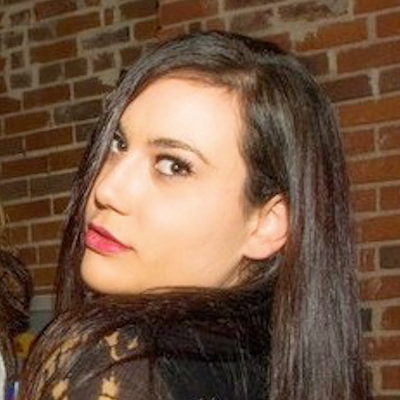Art has been given new life on the wall of Potager, a garden spot of a restaurant in Capitol Hill. After eight years, abstract artist Andrew Hockenberry returned to Denver from New York City to restore his mural on the north-facing wall of the beloved eatery that Teri Rippeto opened in 1997.
Hockenberry, who still has connections in the city as well as family in the mountains, today holds down a day job as a bartender at the famous Keens Steakhouse in New York while he continues to pursue art. He was also working in the restaurant industry and making art back in 2008 when he decided to paint the original piece. At the time, he lived in a garden-level apartment in the complex across the parking lot from Potager, which is located at 1109 Ogden Street.
Over the years, his colorful abstract mural had faded a little and some graffiti had collected on the piece. Rather than just do a simple retouching, Hockenberry decided to revisit the city that he loves and gift this wall with his art once again.
Westword caught up with Hockenberry as he put the finishing touches to the mural and spoke with him about coming home, graffiti and the changes in Denver.
Westword: Tell me about how you came to paint this mural on Potager.
Andrew Hockenberry: I started painting in 2002, abstract. I found my style, which was to paint using music as my rhythm — to start painting and not have an idea of the end product, just finding a surface and letting it flow. I moved into a studio in this apartment right here. I was working downtown, in the restaurant business. The sign went horizontal instead of vertical, and there was a beautiful sunset piece on it back then. I watched it get tagged and tagged again, so one morning I just decided to go for it and ask the owners of Potager if I could work on the wall. They said yes.
The piece had been tagged over several times. How do you feel about graffiti? What is your relationship to the graffiti world?
Living in New York City, I've learned a lot about graffiti. And why people graffiti — it's their art form, and I understand. So when something gets tagged, the next person is going to come in and lay something over that tag; it becomes a progression. And that's when the city notices. The idea for the graffiti artists is to make the neighborhood that they live in beautiful. I see graffiti as an art form; I appreciate graffiti. I accept it as a neighborhood responding to the condition of their surroundings. I also appreciated the many years it wasn't tagged. It's a pushing back. As an artist, whether you're a graf artist or a musician, its a chance to express yourself without judgment.
You mentioned listening to music and painting in a stream-of-consciousness style. What are you listening to now, and what were you listening to then?
I listen to all kinds of music. Right now, I'm listening to Portugal. the Man. When I first started painting this, it was a lot of Miles Davis. I started this painting at 2 a.m. in the middle of summer. I lit this block with lights and started painting to Miles Davis 'til about 7 in the morning. It took me a month to sand-scrape the whole building. I laid five coats of white on it. I laid in the border. I took sketches of the sign, so the lettering is the same lettering of the original horizontal sign. I took the Potager text down, made it vertical, but kept the original font traced on these envelopes.
What are the most notable differences in Denver? Do you think gentrification is taking over?
I see development, not gentrification. I think Denver is the same as it was fifteen years ago. The same people working the same jobs. It just has a lot more money pumped into it now, which is great for the city. People should appreciate the modern lifestyle they have. It's always been a modern city, ever since I got here. It's not so much gentrification, it's just modernization. It's an idea of a healthy lifestyle available for everyone — you just have to find it. It's a natural progression for a city, and it's not personal.
Sure, you can move to Steamboat. But you're not going to have convenience. Denver is about convenience and production and productivity. And I think that's a great thing. Denver has found a way to build smart and beautifully and to stay how it used to be. Denver businesses haven't changed; they've grown. I remember eight years ago when Sexy Pizza opened across the street. The idea of what Denver was ten years ago, it is today.
Find out more about Andrew Hockenberry's work and view his portfolio. Visit the fresh new mural at Potager at 1109 Ogden Street.
[
{
"name": "Air - MediumRectangle - Inline Content - Mobile Display Size",
"component": "12017618",
"insertPoint": "2",
"requiredCountToDisplay": "2"
},{
"name": "Editor Picks",
"component": "17242653",
"insertPoint": "4",
"requiredCountToDisplay": "1"
},{
"name": "Inline Links",
"component": "18838239",
"insertPoint": "8th",
"startingPoint": 8,
"requiredCountToDisplay": "7",
"maxInsertions": 25
},{
"name": "Air - MediumRectangle - Combo - Inline Content",
"component": "17261320",
"insertPoint": "8th",
"startingPoint": 8,
"requiredCountToDisplay": "7",
"maxInsertions": 25
},{
"name": "Inline Links",
"component": "18838239",
"insertPoint": "8th",
"startingPoint": 12,
"requiredCountToDisplay": "11",
"maxInsertions": 25
},{
"name": "Air - Leaderboard Tower - Combo - Inline Content",
"component": "17261321",
"insertPoint": "8th",
"startingPoint": 12,
"requiredCountToDisplay": "11",
"maxInsertions": 25
}
]











